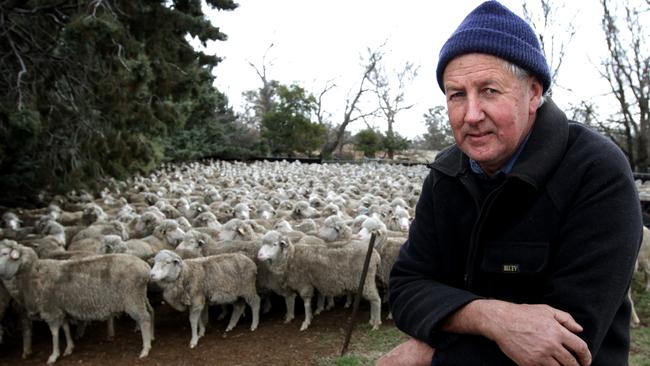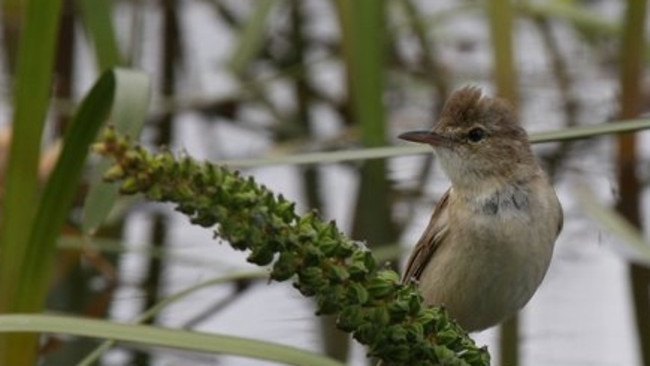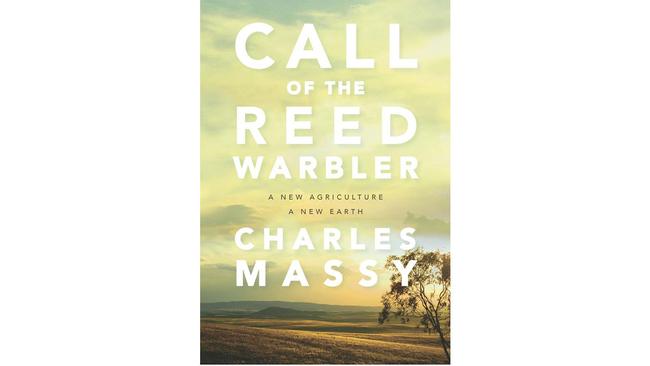Charles Massy’s Call of the Reed Warbler: it’s time to wake up
Charles Massy’s cry from the heart about the destruction man can wreak is compulsive reading.

The most important sentence of this hugely consequential book, one that should be engraved into every kerb and gutter, graffitied on every highway overpass in the country, arrives 291 pages in: “Our ideas are part of the ecosystem we inhabit.”
The words don’t belong to the author (Charles Massy is quoting a 1967 paper by historian Lynn White) yet his entire undertaking — thoughtful, impeccably researched, ambitious and built on decades of practical trial and error and hard abstract thinking — rests on them.
But what do they mean? For more than 50,000 thousand years, indigenous peoples practised proto-agriculture across the Australian continent. They farmed with firesticks, engaged in aquaculture, selectively culled animal populations, encouraged perennial grasses for grazing and developed a grain belt far larger than the one that exists today. Careful stewardship was at the centre of what US ecologist Aldo Leopold would describe as a “land ethic” — a holistic system that welded religion, myth, philosophy and human law with what the rural peasantry of Europe would call “husbandry”.
The result was a distinct set of practices designed for a dry, nutrient-poor, fire-prone land that provided its inhabitants with a relatively stable and ecologically rich breadbasket, maintained for tens of millennia before comparable domestication of landscape occurred in Europe. Call of the Reed Warbler is the description, undertaken by a fifth-generation sheep grazier turned ecologist from NSW’s Monaro region, of what happened when Europeans arrived and unsettled this immemorial regime. The result has been nothing short of desecration.
Sheep, writes Massy, ate “the heart out of the land”. Native vegetation was cleared, trees felled, creeks strangled, paddocks tilled to bare earth so soil that had taken thousands of years to build was lost to flood and wind. Massy returns us in these pages to the regions of western Victoria that Thomas Mitchell called Australia Felix to show how early settlers took a region with soil so deep and uncompacted that the ruts of the explorer’s cart were still visible decades later, and denuded it within decades.
He reminds us of the great eucalypt die-off of New England in the 1970s and 80s, when the cumulative effect of decades of fertiliser use and understory clearing upset the balance between certain insects and their predators, turning the landscape into a vast arboreal graveyard.
The most telling moments in this catalogue of agricultural error tend to be glancing, however; smuggled in via memory or anecdote. There is the middle-aged farmer from NSW who recalls asking his father as a child if he, too, could build a home out of timber from the property on which they had lived for generations — as their original homestead was — only to be tersely disabused of his ambition, since the farm’s trees were all gone.

Or the old cocky near Cooma who, in Massy’s childhood remembrance, proudly strung along his fence-line the corpses of two dozen wedge-tailed eagles he had poisoned or shot. Or the climbing trip on the Tasman Glacier in New Zealand, undertaken by the author as a young man, where he picked a reddish chip from a thin layer of frozen discolouration and asked his companion, a local, whether it was algae. The Kiwi replied that it was no such thing — it was dust from the Mallee drought of the 1930s, when a million jumbo jets’ worth of Australian soil was blown into the stratosphere.
Across almost 600 pages — heavily footnoted, replete with case studies, interviews, personal recollections, and tidy summations of current science and emergent thinking — Massy outlines what can only be regarded as the ecological concomitant to the frontier conflict that marked Europeans’ annexation of the continent. A violence was practised on the Australian landscape by generations of farmers — not out of malice or stupidity, but because the agricultural practices they brought, the ideologies of land ownership and land use embedded in them, were not fit for purpose, and therefore inherently destructive.
What saves Massy’s book from being merely a black-armband vision of Australian agriculture is twofold. First, the author is both a perpetrator and victim of what he calls the “mechanical mind” outlined above.
Even though his early passion was for zoology — Massy is a born naturalist — the early death of the author’s father meant he was obliged to break off further study at the Australian National University and return to take over the family farm at the tender age of 22.
For years, he admits in shame and some despair, Massy pursued traditional Australian land management, with all its increasingly obvious defects, while cordoning off the ecological intelligence he had gleaned from his studies. Massy, too, has ploughed his paddocks into dustbowls, destroyed the microbial life in his soils with excessive fertiliser use, pushed out native grasses and trees in favour of monoculture crops. Like so many farmers, he has impotently shaken his fist at a sky free of rain clouds for months at a time.
It was his consultancy work as a wool classer and merino ram adviser that gave Massy a broader perspective than most. Obliged to travel right across Australia, up to 70,000km a year, he witnessed his own errors ramified across the landscape. After initially being cracked open by the horror drought of the early 80s, eventually, after 35 years on the land, he returned to ANU to complete a PhD in ecology.
Massy’s second saving grace is that, although he never underestimates the scale of the challenges facing farmers here and worldwide, and is fully cognisant of the threat posed by changing climate and widespread soil degradation, he maintains a quiet certainty that the right things will be done. He places his trust for the future in the rebel farmers not bastardised by the system who, in varying ways, have created a regenerative agriculture, one more closely fretted to the landscape in which they are embedded, practised in ways less in thrall to industrial methods and mindsets.
So, while Massy’s evolution as a farmer and ecological thinker is the central thread of the work, Call of the Reed Warbler is generously given over to a series of case studies involving others, in Australia and overseas, who have bumped up against the limits of industrial agriculture and, sometimes pragmatically, sometimes idealistically, set about making a success out of subverting the dominant agricultural paradigm.

There is Tim Wright, nephew of the poet Judith Wright, who, beleaguered psychologically and financially by the early 80s drought, took up the holistic grazing practices advocated by Zimbabweans Allan Savory and Stan Parsons in the New England district. He went from a few 20ha paddocks to more than 300 of 8ha or less.
Densely stocked but quickly circulated, his farm’s bio-mimicry of ancient animal movements — concentrated herds moving swiftly over land — has entirely reinvigorated the millions of solar panels on which all land relies: dense plantings of grasses and plants more generally.
Then there is Colin Seis, based near Gulgong in NSW, who, burned out by fire and left with no money to rebuild, began practising by necessity a no-input agriculture that eschewed ploughing entirely.
By integrating native perennial pastures with annual crops, and moving livestock through them at regular intervals, Seis has taken light, marginal country and turned it into a remarkable showcase for regenerative agriculture.
Numerous others — men and women, old and young, hippies and squatocrats, rich and arse-out-of-trousers poor — are visited and gently interrogated over a warm teapot by Massy. And what commonalities emerge from their conversion experience converge on two points: some extremity, climatic or economic or personal, jolts ordinary folk from their agricultural rut; and subsequent success emerges from moving to a form of agriculture that, to a lesser or greater extent, involves farmers getting out of the way of nature’s self-regulation.
Doubtless many reading this review are wondering what on earth Australian regenerative agricultural practices have to do with them. The answer is: absolutely everything. What Call of the Reed Warbler is venturing, in both its admonitory and hortatory modes, is to remind us that culture of the kind found in literature, in books, even the arts pages of newspapers, is nested in agriculture — because without the necessary structures and supports agriculture provides, culture is impossible.
More obvious yet radical still is Massy’s argument that even many farmers have forgotten: agriculture is nested in nature. Without healthy ecosystems, agriculture is also impossible. Only a revolution in the way that farmers view their place in relation to broader natural systems will save the rest of us; and only the iconoclasts among the agricultural community will push us towards that fresh understanding. Call of the Reed Warbler is the most sustained, significant, and heartfelt effort to celebrate and justify the efforts of this ground-level revolution. It discovers that the true ecological problem lies in the 15cm between our ears.
This is a beautiful book, both in the language in which it is couched and because of the ideas it propounds; but it is also a necessary one. It asks us — as decent citizens, as ethical agents, as humans desiring to persist in the face of the gravest ecological challenge in our history as a species — to prioritise the question every indigenous Australian habitually asked themselves before we arrived with our Enlightenment certitude, our mechanistically minded arrogance, and royally screwed up everything: “What can I do for country?”
Geordie Williamson is chief literary critic of The Australian.
Call of the Reed Warbler: A New Agriculture, A New Earth
By Charles Massy
UQP, 592pp, $39.95



